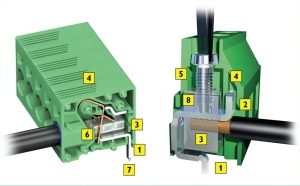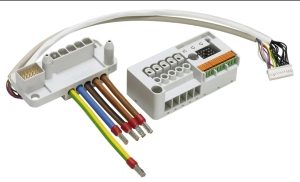Custom Connectors Unleashed: From Pain Points to Full-Cycle Solution Design
In electronic device design, connector reliability directly impacts product performance, yet industries often prioritize cost over quality. Custom solutions become essential when standard connectors fail to meet:
- Environmental demands: High-temperature (125°C+) industrial setups, medical sterilization needs, UV-resistant outdoor applications
- Functional integration: Mixed power/signal/data transmission, compact high-density layouts (e.g., micro-sensor modules)
- Compatibility challenges: Non-standard interfaces, mechanical retrofits for legacy equipment
- Cost optimization: Modular design to reduce redundant features in mass production

Custom connectors in industrial robotics
| Dimension | Standard Solutions Limitations | Customization Value Proposition |
|---|
| Performance Matching | Generic materials compromise temperature/conductivity | Industrial PCB terminal blocks with polyamide housing + gold-plated copper contacts: V0 flammability, 125°C tolerance, low resistance |
| Cost Control | Unnecessary features inflate costs | Modular customization (e.g., custom housing + standard clamping) reduces development costs by 30-50% |
| Design Integration | Multiple connectors cause bulk and wiring complexity | Mixed connectors integrate power/signal, shrinking size by 40% and boosting wiring efficiency by 60% |
- Material Matrix:
▶ Industrial: Polyamide (PA) – V0 flame rating, chemical resistance, 125°C operation
▶ Medical: PEI (Polyetherimide) – Ethylene oxide sterilization compatibility
▶ High-frequency: LCP (Liquid Crystal Polymer) – Low Dk (<3.0), reflow soldering tolerance (260°C) - Structural Enhancements:
✅ Tapered pin design: ±0.05mm positioning accuracy, prevents contact deformation
✅ Stress-relief arcs: Mitigates micro-cracking during assembly

Elements of fixed single-piece design
- Contact Systems:
▶ Power connectors: Beryllium copper + 50μin gold plating (contact resistance <10mΩ, 20% higher current capacity)
▶ Signal connectors: Phosphor bronze + nickel-gold plating (5,000+ mating cycles, >60dB crosstalk suppression) - Innovative Termination:
⬤ Spring-loaded technology: Tool-free wiring for 22-10AWG wires, 3x faster termination
⬤ Reakdyn mechanical locking: Vibration-proof (50G acceleration test)
- EMI shielding: Custom metal enclosures + gaskets (80dB attenuation at 1GHz)
- Smart integration: Embedded temperature sensors (±1°C accuracy) or RFID tags
- Traceability: Laser-engraved QR codes with batch/lot information

Phoenix Contact customized connection solutions
- Needs Definition: Electrical parameters (voltage/current/frequency), mechanical specs (IP rating), environmental conditions
- Feasibility Analysis: DFMA assessment (standard part reuse ≥60% to control costs)
- Design Engineering: 3D modeling + FEA simulation for thermal stress/vibration fatigue
- Prototype Validation: Salt spray (1,000hrs), thermal cycling (-40°C~125°C, 1,000 cycles)
- Mass Production: Mold flow analysis + SPC for process consistency
In an industrial robotics application, a φ12mm interface integrated 4x power channels (24V/10A) and 16x signal lines (CANopen), replacing 3 standard connectors:
- Technical breakthrough: Layered terminal structure (crosstalk <50dB)
- Performance: IP67, 50Hz~2000Hz vibration resistance, -40°C~85°C operation
- ROI: 60% fewer components, 70% reduced wiring time, 45% cost savings
- Technical capability: Material labs (DSC/TGA) and simulation tools (ANSYS/ABAQUS)
- Manufacturing precision: Multi-shot molding (±0.02mm), automated plating (±5% thickness control)
- Certifications: ISO 9001+IATF 16949, UL/VDE/CE compliance
Custom connectors have evolved from passive components to active system performance drivers in Industry 4.0. By aligning material science, structural innovation, and modular design, businesses can resolve technical bottlenecks while building differentiated products. Partner with full-chain manufacturers to leverage standard modules for rapid innovation deployment.







